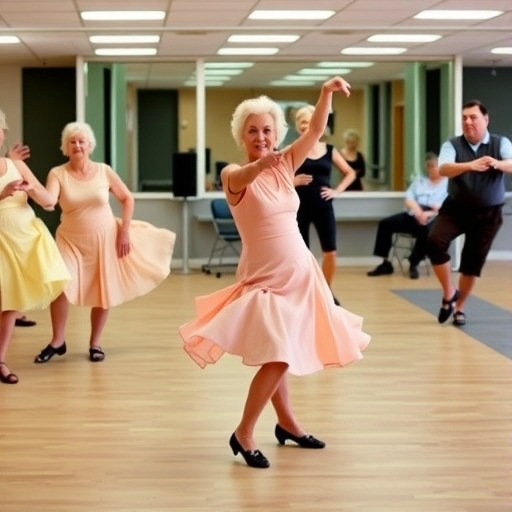Within the aging population, the importance of physical exercise cannot be overstated. Recent research has illuminated how specific forms of dance, particularly traditional styles, can have transformative effects on physical health. In this context, a remarkable study led by researchers Chen, Su, and Holmes focused on the impacts of Classical Chinese Dance on older adults. Their findings suggest that engaging in this centuries-old art form over a short duration can lead to substantial improvements in flexibility, balance, and muscle strength.
The study spans ten weeks and meticulously documents the changes observed in a group of elderly participants. As the population ages, the health-related challenges associated with reduced mobility and physical degeneration become increasingly prevalent. It is essential to explore alternative and innovative avenues to promote well-being among older individuals. This research provided a structured training program, integrating Classical Chinese Dance techniques that are not only physically demanding but also culturally enriching.
Throughout the ten weeks, participants embarked on a rigorous training regimen that incorporated key elements of Classical Chinese Dance. These elements emphasize graceful movements and complex choreography, which challenge various physical capabilities, and appeal to both the mind and body. Through this structured approach, the researchers aimed to document the specific physiological benefits associated with this form of dance.
Flexibility is one of the primary benefits that surfaced from this training. Dance inherently requires a range of motion that is often beyond the capabilities of many elderly individuals. The study found that participants experienced significant improvements in their flexibility scores. Enhanced flexibility can lead to a reduction in the risk of falls, which is one of the leading concerns for older adults. As flexibility increases, so too does the ability to navigate the environment safely and confidently.
In addition to flexibility, balance is a crucial component of physical health in older age. The study specifically measured improvements in balance through various standardized tests. As the elderly participants engaged with the rhythmic movements and stances involved in Classical Chinese Dance, their stability markedly improved. The dance’s emphasis on core strength and posture directly contributed to their enhanced ability to maintain balance, a critical factor in reducing fall risk.
Muscle strength was another area where participants saw measurable gains. Traditional exercises often target specific muscle groups, but dance takes a holistic approach, engaging multiple muscle systems simultaneously. This multi-faceted involvement ensures that core muscles are strengthened, thus promoting overall stability and mobility. As a result, older adults who participated in the study reported feeling stronger and more capable of performing daily tasks without the fear of injury.
Moreover, the psychological benefits accompanying the physical improvements are noteworthy. Engaging in dance fosters a sense of community and social connection, which is often lacking in the lives of many elderly individuals. The group dynamic observed in the study contributed to elevated morale and improved mental health among participants. This aspect cannot be underestimated because emotional well-being is an integral part of holistic health.
The cultural engagement afforded by Classical Chinese Dance also enriched the experience for participants. This form of dance is deeply rooted in tradition, providing not only physical exercise but also an opportunity for cultural appreciation. Participants learned about the history and significance behind the dance movements, thus enhancing their engagement with the activity. This cultural connection can be particularly valuable in fostering a sense of purpose and identity among older individuals, encouraging them to stay active.
The study employed rigorous methods to ensure that the results were both reliable and valid. Standardized testing protocols were utilized before and after the intervention, allowing for an accurate measurement of improvements. This methodological rigor lends credibility to the findings, suggesting that the benefits of Classical Chinese Dance are not merely anecdotal but rather substantiated by scientific investigation.
One of the most significant implications of this research is its potential to influence public health policy. As societies grapple with the challenges of aging populations, incorporating alternative forms of exercise like dance into community programming could serve as a valuable strategy. Local health organizations and recreational centers might consider adopting structured dance programs, acknowledging that they could provide not only physical benefits but also social and psychological support.
Future research could further explore the long-term effects of engaging in Classical Chinese Dance among different demographics. While this study focused on older adults, expanding the scope to include varied age groups or individuals with different health conditions could yield broader insights. Understanding how dance impacts diverse populations will be critical to maximizing its benefits across the lifespan.
As the findings of this study circulate, they have the potential to inspire a movement toward integrating artistic forms of physical exercise into daily routines for seniors. Encouraging older adults to partake in activities that promote flexibility, balance, and strength can empower them to take charge of their health. The message is clear: innovation in physical activity, particularly that which embraces culture, is crucial for enhancing the quality of life as we age.
In conclusion, the research conducted by Chen, Su, and Holmes sheds a bright light on the myriad benefits of Classical Chinese Dance for the elderly. With significant improvements in flexibility, balance, and muscle strength documented, the findings pave the way for a more active and fulfilling life for older adults. By endorsing the integration of dance into fitness regimens, society can work towards decreasing the physical limitations associated with aging and enhancing overall health and well-being.
Subject of Research: Effects of Classical Chinese Dance on Elderly Health
Article Title: Effects of 10 Weeks Classical Chinese Dance Training on Flexibility, Balance and Muscle Strength of the Elderly.
Article References:
Chen, CL., Su, WS., Holmes, M.W. et al. Effects of 10 Weeks Classical Chinese Dance Training on Flexibility, Balance and Muscle Strength of the Elderly. J. Med. Biol. Eng. (2025). https://doi.org/10.1007/s40846-025-00964-1
Image Credits: AI Generated
DOI: 10.1007/s40846-025-00964-1
Keywords: Classical Chinese Dance, elderly health, flexibility, balance, muscle strength, physical activity, senior fitness, community health, aging population




